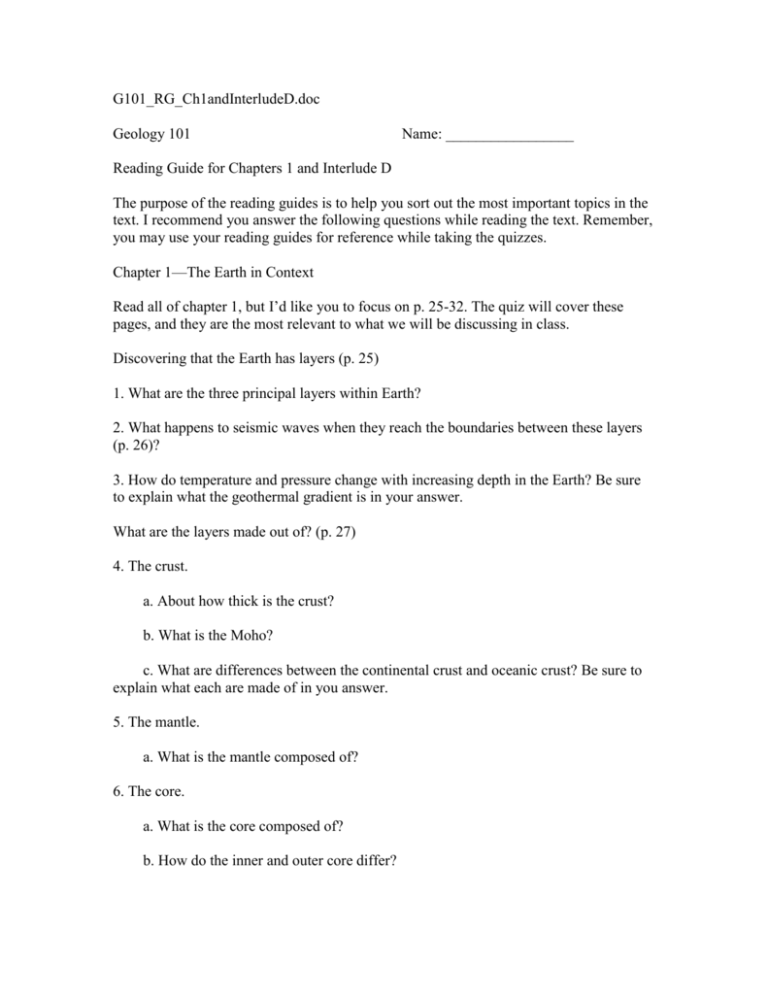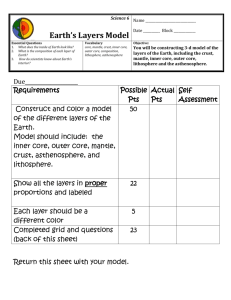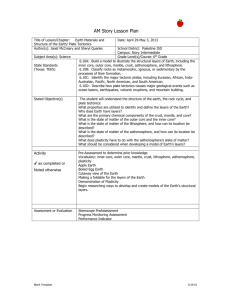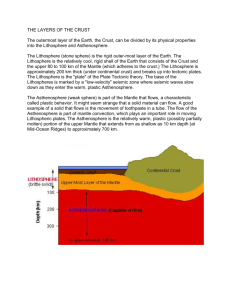Reading Guide for Ch1, Interlude D
advertisement

G101_RG_Ch1andInterludeD.doc Geology 101 Name: _________________ Reading Guide for Chapters 1 and Interlude D The purpose of the reading guides is to help you sort out the most important topics in the text. I recommend you answer the following questions while reading the text. Remember, you may use your reading guides for reference while taking the quizzes. Chapter 1—The Earth in Context Read all of chapter 1, but I’d like you to focus on p. 25-32. The quiz will cover these pages, and they are the most relevant to what we will be discussing in class. Discovering that the Earth has layers (p. 25) 1. What are the three principal layers within Earth? 2. What happens to seismic waves when they reach the boundaries between these layers (p. 26)? 3. How do temperature and pressure change with increasing depth in the Earth? Be sure to explain what the geothermal gradient is in your answer. What are the layers made out of? (p. 27) 4. The crust. a. About how thick is the crust? b. What is the Moho? c. What are differences between the continental crust and oceanic crust? Be sure to explain what each are made of in you answer. 5. The mantle. a. What is the mantle composed of? 6. The core. a. What is the core composed of? b. How do the inner and outer core differ? The lithosphere and asthenosphere (p. 29) 7. Define the following terms: a. lithosphere b. asthenosphere: 8. What is the difference between the lithosphere and asthenosphere in terms of: a. what they are composed of: b. temperature: c. Which layer is softer and is capable of flow? 9. Draw a simple sketch of the major layers that make up the Earth’s interior, show the locations of the Crust, Mantle, and Core and also label the position of the lithosphere, asthenosphere, outer core, and inner core. We will be referring to these different layers throughout the class. Interlude D—Seeing Inside the Earth Read all of Interlude D, beginning on page 232. D.2. The Movement of Seismic Waves Through the Earth. 1. What three factors influence the ability of a seismic wave to travel through a certain material? 2. What materials can a P-wave travel through? What materials can a S-wave travel through? 3. How is reflection different from refraction? D.3. Seismic study of Earth’s interior. 4. What causes the low-velocity zone in the mantle? 5. Describe how seismic waves were used to distinguish between the inner and outer core D.4. Fine-tuning our image of the Earth’s interior. 6. Define seismic tomography. 7. What practical uses does seismic-reflection profiling have? Published by Google Docs–Report Abuse–Updated automatically every 5 minutes Geology 101 Name: _________________ Reading Guide for Chapters 1 The purpose of the reading guides is to help you sort out the most important topics in the text. I recommend you answer the following questions while reading the text. Remember, you may use your reading guides for reference while taking the quizzes. Chapter 1—The Earth in Context Read all of chapter 1, but I’d like you to focus on p. 24-32. The quiz will cover these pages, and they are the most relevant to what we will be discussing in class. Discovering that the Earth has layers 1. What are the three principal layers within Earth? 2. What happens to earthquake waves when they reach the boundaries between these layers (p. 26)? 3. How do temperature and pressure change with increasing depth in the Earth? Be sure to explain what the geothermal gradient is in your answer. What are the layers made out of? 4. The crust. a. About how thick is the crust? b. What is the Moho? c. What are differences between the continental crust and oceanic crust? Be sure to explain what each are made of in you answer. 5. The mantle. a. What is the mantle composed of? 6. The core. a. What is the core composed of? b. How do the inner and outer core differ? The lithosphere and asthenosphere 7. Define the following terms: a. lithosphere b. asthenosphere: 8. What is the difference between the lithosphere and asthenosphere in terms of: a. what they are composed of: b. temperature: c. Which layer is softer and is capable of flow? 9. Draw a simple sketch of the major layers that make up the Earth’s interior, show the locations of the Crust, Mantle, and Core and also label the position of the lithosphere, asthenosphere, outer core, and inner core. We will be referring to these different layers throughout the class.







